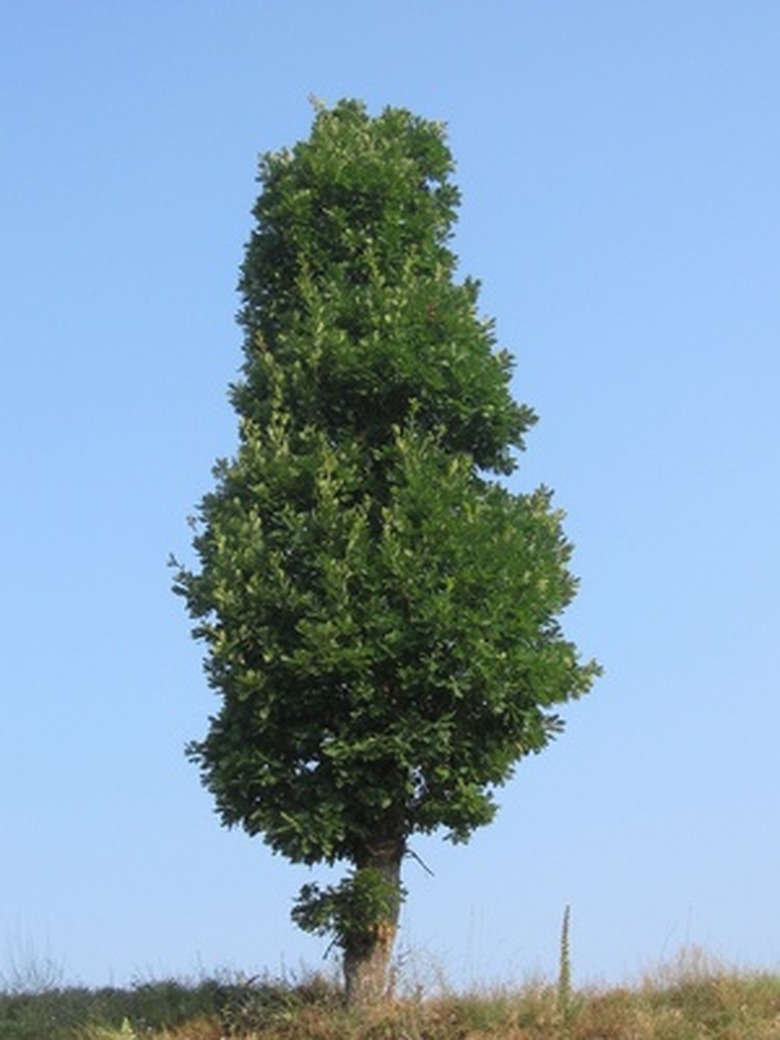How To Remove Evergreens
The term "evergreen" covers a wide range of tree varieties, from conifers to junipers. While each type of evergreen has slightly different characteristics, they all have one thing in common–a deep root system that makes them difficult to kill and to remove. The best way to remove an evergreen is to cut it down, but keep in mind that simply cutting down an evergreen is only half the job–the stump and roots must be killed and/or removed in order to keep suckers and sprouts from reappearing, sometimes for years to come.
Step 1
Determine the height of your tree so you will know how much space you need in order to let it safely fall once it is cut. You don't want your evergreen crashing through your roof or through a neighbor's roof. Plan exactly which direction you want your tree to fall in, and make sure it can do so safely.
Step 2
Use your chainsaw to cut a notch on the side of the tree facing the direction that you want the tree to fall. Cut down at a 45-degree angle and then cut up at a 45-degree angle until the two cuts meet. Remove the notch. The notch should be at least 1/3 of the way through the trunk of the tree.
- The term "evergreen" covers a wide range of tree varieties, from conifers to junipers.
- The best way to remove an evergreen is to cut it down, but keep in mind that simply cutting down an evergreen is only half the job–the stump and roots must be killed and/or removed in order to keep suckers and sprouts from reappearing, sometimes for years to come.
Step 3
Use your chainsaw to make a straight cut through the trunk of the tree from the side opposite the notch, so that the cut is aimed at the center of the notch.
Step 4
Just before your straight cut from the side of the tree opposite the notch reaches the notch, your tree should begin to fall in the direction of the notch. Once your tree begins to fall you need to get out of the way. Run in the direction opposite the notch.
Step 5
Cut up the fallen tree with your chainsaw into pieces which can be easily burned or which can be bundled and put out with your trash. Check with your local refuse department for their bundling requirements for felled trees.
Step 6
Cut the stump flush with the ground with your chainsaw. Use your drill to drill as many 3/8" holes into the stump as you can, drilling each hole as deep as you can.
- Use your chainsaw to make a straight cut through the trunk of the tree from the side opposite the notch, so that the cut is aimed at the center of the notch.
Step 7
Fill each hole with a high-nitrogen fertilizer, the higher the nitrogen content the better. High-nitrogen fertilizer will encourage bacterial growth, and the bacteria will begin decomposing the stump. Add water to the fertilizer in the holes, and then spread additional fertilizer on top of the stump and add more water. Sprinkle dirt on top of the fertilizer and dampen again. Keep the stump damp for four weeks.
Step 8
Grind the dead stump down at least 12 inches deep with a stump grinder four weeks after applying the high-nitrogen fertilizer. The stump should now be dead and the roots will die once the stump itself is ground away. Fill in the hole with soil and water.
- Fill each hole with a high-nitrogen fertilizer, the higher the nitrogen content the better.
- Add water to the fertilizer in the holes, and then spread additional fertilizer on top of the stump and add more water.
Tip
Always wear eye protection, gloves and ear protection whenever using a chainsaw or a stump grinder. Stump grinders can be rented at your local hardware store or home improvement center. Follow all of the manufacturer's instructions when using a stump grinder.
Warning
When your tree begins to fall, run the other way.
Things Needed
- Chainsaw
- Gloves
- Ear protection
- Eye goggles
- Drill with 3/8" bit
- High-nitrogen fertilizer
- Water
- Stump grinder
